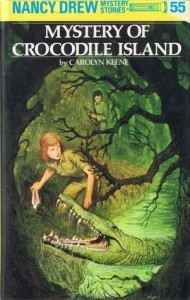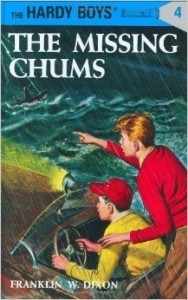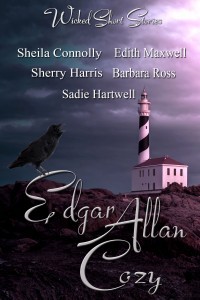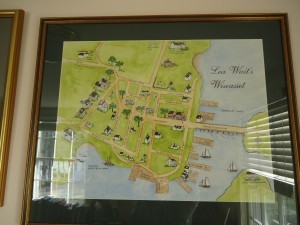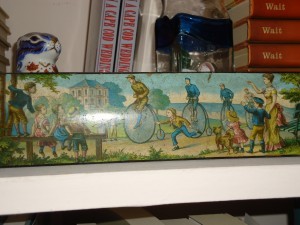Kathy Lynn Emerson's Blog, page 84
January 28, 2016
the Death of an Old Family Friend
John Clark reprising a piece I wrote for Wolf Moon Journal back in 2005 in the hope it brightens your day as we creep into February.
On the Death of An Old Family Friend
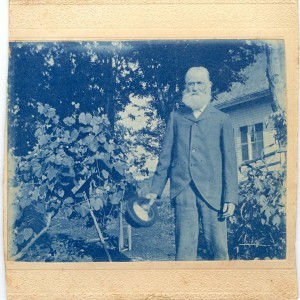
Great grandfather Horatio Clark who was one of many in the family who loved to garden and fish
When you marry, you gain more than a partner. You acquire new relatives, different ways of thinking, new customs and family celebrations. All of these are more or less expected parts of a new blended life. If you are lucky, you gain some unexpected things as well. I gained new realms to explore, and I did; hunting and fishing through parts of Maine that had previously been odd names on a topographic map.
I got in the habit of sitting on the front steps with my father-in-law. He would talk about catching trout in a spot a couple miles in from a particular tote road or trolling for salmon just before dusk with a Rangely spinner below a certain dam. As we watched the setting sun creep across the hill on the other side of the road, I would share my own memories of fly fishing the Carabasset River with my father before it was lined with ski chalets, and trout were still plentiful enough to be fooled by eight year old boys. I=d reminisce about the gold nugget my grandfather found while fishing the North branch of the Dead River and how my father would hike nine miles into Spencer Stream to catch monster trout. These were companionable moments interspersed with the cry of hawks and the beckoning sounds of float planes on their way to Moosehead Lake.
I began to explore some of these inherited realms, sometimes alone, sometimes with my wife or friends. There was something magic about wading down the middle of a stream, chest deep in cool water, automatically casting streamer flies while lost in thought. Sometimes those moments would be pleasantly interrupted by the sharp tug of a hungry trout or the wary gaze of a deer caught in the act of drinking. By the end of the day, my body would be tired and my soul recharged.
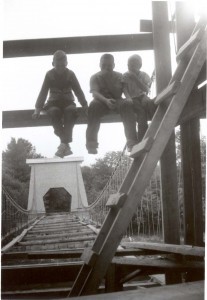
Fixing the Wire bridge over the Carrabasssett River not far from my grandparents’ house in New Portland
Certain spots began to acquire their own lore; The overgrown blueberry field where a bear was surprised while eating grubs from an anthill, the streamside trail where a mother hawk maintained her uneasy vigil until satisfied that we were uninterested in her hatchlings, the remote pond where moose and deer ambled through the shallows together, completely indifferent to our presence, the springhole where I suddenly found myself chest deep in frigid water while ice fishing. Each became a part of a blended heritage to be shared with my children while sitting on front steps and listening to the sounds of summer.
One August, while fishing one of my inherited streams, I dangled a fly in a small pool below the remnants of a long destroyed mill. The spot had often rewarded me with dinner. To my astonishment a huge brook trout swam out of the jumble of old millwork to eye my offering. After looking it over with the contemptuous experience of trout-like wisdom, he turned gracefully and swam back into the rocky den from whence he had come. I was stunned! In years of fishing this brook, nothing of this size had ever shown itself, not had there ever been a hint a fish this big existed. Numerous attempts with different flies resulted in a couple curtain calls, but nary a nibble. I returned home to share my adventure. Over the rest of the season, I returned several times. Each time my mammoth friend would emerge, eye my offering and grandly swim back to his rocky hideaway. His pool was so small and his length so long that he had to use the entire pool to turn around. One evening just before the season closed, I brought Beth with me and she was treated to a command performance complete with a tentative nibble on the evening‘s offering.
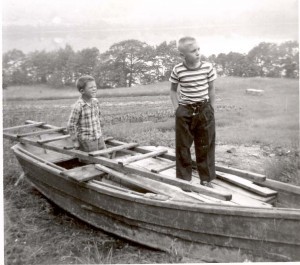
Even when the boat wasn’t ready, I was thinking about fishing as a kid.
Summer slipped into fall, fishing was replaced by duck hunting and then by deer hunting. Winter brought holiday gatherings where I shared the story of my mammoth friend with those from >away=. Ice fishing became the prime weekend activity, with slow periods filled by meals cooked over outdoor fires and everyone remembering fishing tales from past seasons. More than once I shared the story of my friend and we all wondered how such a large fish had come to live in such a small pool.
As winter faded into spring, Maine experienced what was to become known as the 500 Year Flood. Heavy rains rapidly ate away the snow cover, creating torrents where small rivulets had been just the day before. River towns were evacuated and it seemed like entire forests were rushing madly under bridges. The events surrounding the flooding and the safety of loved ones erased all thoughts of my friend.
When spring once more passed its mantle of green to summer, I returned to the stream. As I approached the old mill site, I was saddened at the changes wrought by the flood. Pools I had fished for years were unrecognizable, with rocks pushed far downstream. The remains of the old mill were gone. After an hour of fishing in every possible spot, I realized my friend was gone. Smaller fish still lurked among the nearby rocks, but the big trout was just a memory to be shared with friends and family on summer afternoons when the siren song of float planes headed for remote ponds fill the skies.

If you’d rather be here right now, raise your hand.
January 26, 2016
Finding Faces
Kaitlyn Dunnett/Kathy Lynn Emerson here. It’s confession time—I’m not very good at finding fresh ways to describe the physical appearance of my characters. What do they look like? Sometimes I have no idea.
I do make character sheets on which I record height, weight, build, hair and eye color and so on, but when it comes to finding a way to make each one stand out for the reader I am always left fumbling for the right words.
Over the years I’ve worked up a “cheat sheet” listing details that describe a character’s attributes. It’s broken down into the following categories: attitude, build, complexion, ears, eyes, face and facial hair, fingers, gait, hair, hands, laugh, nervous habits, nose, smell, and voice. Yes, those are alphabetical. No, they don’t have a particular rationale behind them, other than being areas where I’ve managed to accumulate a variety of descriptive words and phrases that I can mix and match when creating a new character. Under gait, for example, the list includes awkward, slight limp, rolling, slow-moving, hobbling, scuttling, shambling, light on his feet, shuffling movement, and flat-footed. Hair omits the standard colors and includes straw-colored, mud-colored, rich blue-black that reflects the sunlight, sand-colored, ginger, and also lank, bald, thinning, and receding hairline.
 Such word lists are great as far as they go, but sometimes I have the feeling I should be doing more. When I was working on The Scottie Barked at Midnight, which has an unusually large cast of new characters, I decided to try something I know some writers have used successfully—clipping photos from magazine ads to help visualize what their characters look like. The problem, of course, is that most of the people in those are too good looking. News stories provide more variety. In fact, years ago, I had a certain small-time Maine politician in mind when I was creating a particularly smarmy villain.
Such word lists are great as far as they go, but sometimes I have the feeling I should be doing more. When I was working on The Scottie Barked at Midnight, which has an unusually large cast of new characters, I decided to try something I know some writers have used successfully—clipping photos from magazine ads to help visualize what their characters look like. The problem, of course, is that most of the people in those are too good looking. News stories provide more variety. In fact, years ago, I had a certain small-time Maine politician in mind when I was creating a particularly smarmy villain.
 Other than that, though, the only time I’ve matched a character with a real person’s picture was after the fact. Rosamond Jaffrey’s late, unlamented father, Sir Robert Appleton, from my Face Down mysteries and, now, the Mistress Jaffrey mystery series I write as Kathy Lynn Emerson, found his perfect embodiment in Colin Firth, as seen as the not-so-nice Lord Wessex in Shakespeare in Love. Other attempts to find faces that match my imaginary people usually end up with me saying “he’s a cross between x and y.”
Other than that, though, the only time I’ve matched a character with a real person’s picture was after the fact. Rosamond Jaffrey’s late, unlamented father, Sir Robert Appleton, from my Face Down mysteries and, now, the Mistress Jaffrey mystery series I write as Kathy Lynn Emerson, found his perfect embodiment in Colin Firth, as seen as the not-so-nice Lord Wessex in Shakespeare in Love. Other attempts to find faces that match my imaginary people usually end up with me saying “he’s a cross between x and y.”
 One caveat—it’s almost always a bad idea to come right out and describe someone as looking like a celebrity. For one thing, it dates the book. And, of course, this doesn’t work at all well in an historical unless you’re sure your readers will know what a character means when he says someone is a dead ringer for Lord Byron or King Henry or Bram Stoker (who, incidentally, was quite a good-looking man).
One caveat—it’s almost always a bad idea to come right out and describe someone as looking like a celebrity. For one thing, it dates the book. And, of course, this doesn’t work at all well in an historical unless you’re sure your readers will know what a character means when he says someone is a dead ringer for Lord Byron or King Henry or Bram Stoker (who, incidentally, was quite a good-looking man).
 But to get back to the Liss MacCrimmon series—the plot of The Scottie Barked at Midnight centers around a television talent competition called Variety, Live. Making up the rules and deciding on each character’s talent was the easy part. I still had to describe each contestant in a way that would make them separate and distinct in the reader’s mind. Second confession—I don’t much care for The Voice or American Idol or any others of that ilk. The only competition I do watch is Dancing with the Stars . . . and that gave me an idea.
But to get back to the Liss MacCrimmon series—the plot of The Scottie Barked at Midnight centers around a television talent competition called Variety, Live. Making up the rules and deciding on each character’s talent was the easy part. I still had to describe each contestant in a way that would make them separate and distinct in the reader’s mind. Second confession—I don’t much care for The Voice or American Idol or any others of that ilk. The only competition I do watch is Dancing with the Stars . . . and that gave me an idea.
 Why not, I asked myself, use former competitors on Dancing with the Stars as the inspiration for my characters? There are certainly plenty of different physical characteristics on display in any given season. So I gave it a try. You’ll have noticed that I’ve sprinkled photos of celebrities throughout this post. The characters they inspired are, in the order they appear in the post, M.C. Roy Eastmont and contestants Willetta Farwell, Mo Heedles, Elise Isley, Iris Jansen, Hal Quarles, and “The Great Umberto” aka Oscar Yates. Keep in mind that I only borrowed physical features, not the real person’s personality or talent.
Why not, I asked myself, use former competitors on Dancing with the Stars as the inspiration for my characters? There are certainly plenty of different physical characteristics on display in any given season. So I gave it a try. You’ll have noticed that I’ve sprinkled photos of celebrities throughout this post. The characters they inspired are, in the order they appear in the post, M.C. Roy Eastmont and contestants Willetta Farwell, Mo Heedles, Elise Isley, Iris Jansen, Hal Quarles, and “The Great Umberto” aka Oscar Yates. Keep in mind that I only borrowed physical features, not the real person’s personality or talent.
 So, what do you think? If you’ve read the book, do these photos fit your idea of the character? If you haven’t read it, does the physical appearance of the person in the picture seem to go well with the character’s name? All bets are off, by the way, for Mo Heedles. She is a real person who won character-naming rights at a Malice Domestic auction after the book was already written. Before that, “Mo” was named Carla Uvedale.
So, what do you think? If you’ve read the book, do these photos fit your idea of the character? If you haven’t read it, does the physical appearance of the person in the picture seem to go well with the character’s name? All bets are off, by the way, for Mo Heedles. She is a real person who won character-naming rights at a Malice Domestic auction after the book was already written. Before that, “Mo” was named Carla Uvedale.
 There’s no question that using this technique gave me the variety I was after for this book, but I found that I had no particular urge to do it again when I was writing this year’s Liss MacCrimmon mystery, Kilt at the Highland Games (July). That said, I’d be very curious to hear about other writers’ experiences in taking the inspiration for their characters’ appearance from pictures of real people. Did it work for you? Have you done it more than once? Chime in, please, and share.
There’s no question that using this technique gave me the variety I was after for this book, but I found that I had no particular urge to do it again when I was writing this year’s Liss MacCrimmon mystery, Kilt at the Highland Games (July). That said, I’d be very curious to hear about other writers’ experiences in taking the inspiration for their characters’ appearance from pictures of real people. Did it work for you? Have you done it more than once? Chime in, please, and share.
Kaitlyn Dunnett/Kathy Lynn Emerson is the author of over fifty books written under several names. She won the Agatha Award in 2008 for best mystery nonfiction for How to Write Killer Historical Mysteries and was an Agatha Award finalist in 2014 in the best mystery short story category for “The Blessing Witch.” Currently she writes the contemporary Liss MacCrimmon Mysteries (The Scottie Barked at Midnight) as Kaitlyn and the historical Mistress Jaffrey Mysteries (Murder in the Merchant’s Hall) as Kathy. The latter series is a spin-off from her earlier “Face Down” series and is set in Elizabethan England. Her websites are www.KaitlynDunnett.com and www.KathyLynnEmerson.com
On Books
Bruce Robert Coffin here. Wishing each of you the best 2016 has to offer.
The other day I was busy editing the manuscript to my second novel — far from finished but editing is something writers do when the writing isn’t going so well — when a random thought popped into my head. What is the big deal about books? No really. They are only paper and ink after all. Only words printed on pages, bound together by a spine, sandwiched between two cloth-covered pieces of cardboard, then wrapped in a shiny dust jacket. Nothing too extraordinary, right?
But if books really are no big deal, if they don’t rise beyond the sum of their parts, why then do we love them so? Why do we erect buildings dedicated to them? Why are we compelled to purchase shelves to hold them, and boxes in which to store them? Why do we display our books on coffee tables and night stands as if they were endearing photos of loved ones? Or race to the store to buy the latest in a series? Or stand in line to have one autographed by a total stranger?
I pondered the question for a while. Pondering is also something writers do, especially when the writing isn’t going so well. Suddenly, the answer came to me, like a bolt of lightning from a clear blue sky (hey, I’m allowed one cliché). Maybe the answer to the question is….that they aren’t really books at all. They are more like portals, capable of whisking us away to strange new places, and new dimensions. To boldly go where no man, or women, has gone before… Sorry, I get carried away.
Books can transport us back to a time when we were different people, younger versions of ourselves. Don’t believe me? Try picking up a copy of Clifford the Big Red Dog or Where the Wild Things Are, then tell me you can’t see images from your childhood dancing before your very eyes. Or Charlie and the Chocolate Factory by Ronald Dahl. I still recall sitting at my desk in third grade while our homeroom teacher read to us. Still remember trying to imagine what an everlasting gobstopper or a snozzberry would taste like.
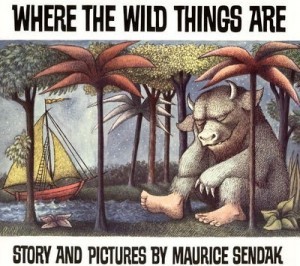
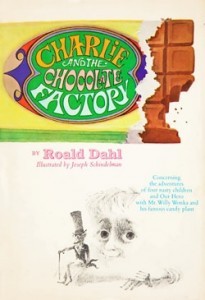 One summer, when I was but a wee lad, I pedaled my bike to a local flea market every week so I could gaze upon their vast collection of antique children’s books. Displayed proudly upon painted shelves was a treasure trove of all things mystery. There were Nancy Drew Mysteries, The Hardy Boys, and Spin and Marty, titles that pre-dated me but intrigued me all the same. I can still remember their musty smell and little white price stickers. Oh, what a quarter would buy. So very captivating were their covers and illustrations. I deliberated over them like an indecisive teen perusing the latest record album bin at the local LaVerdiere’s. Even the book titles were brilliant: The Secret of the Caves, The Ghost at Skeleton Rock, The Whispering Statue, and The Mystery of the Dragon Fire. I had no idea what dragon fire was, but I knew I couldn’t wait to get that book home and delve into its mystery.
One summer, when I was but a wee lad, I pedaled my bike to a local flea market every week so I could gaze upon their vast collection of antique children’s books. Displayed proudly upon painted shelves was a treasure trove of all things mystery. There were Nancy Drew Mysteries, The Hardy Boys, and Spin and Marty, titles that pre-dated me but intrigued me all the same. I can still remember their musty smell and little white price stickers. Oh, what a quarter would buy. So very captivating were their covers and illustrations. I deliberated over them like an indecisive teen perusing the latest record album bin at the local LaVerdiere’s. Even the book titles were brilliant: The Secret of the Caves, The Ghost at Skeleton Rock, The Whispering Statue, and The Mystery of the Dragon Fire. I had no idea what dragon fire was, but I knew I couldn’t wait to get that book home and delve into its mystery.
When I turned twelve, I read my first Stephen King novel, Salem’s Lot. I can still recall the smell of those new pages, the same magical scent as the pop quiz sheets straight from the school office mimeograph. I also remember King’s book scared the hell out of me, as have many of his subsequent works. I read King’s book mostly at night, alone, in my room, frequently unnerved by the feeling that someone was watching me from outside the window. Maybe Danny Glick?
As I aged, my tastes changed, along with my books: One Police Plaza, Tuesdays with Morrie, Of Mice and Men, and A Walk in the Woods. I imagined myself hiking up and down mountains along the Appalachian Trail while chatting with Bryson, or maybe sharing a cream soda with Katz. Each book represented a new chapter in my life, new memories.
More than just paper and ink, books are endless streams of thought and consciousness, knowledge and ideas. Each possessing the power to entertain, to enrich, and to teach us to grow. Books allow us safe passage, an escape from this world to another, if only for a short while. Evoking an infinite number of emotions, the best books are like an amusement park thrill ride, lifting our spirits one moment and then rocketing us downward toward some imaginary horror the next.
What is the big deal about books, you ask? Why not open one and find out?
January 24, 2016
Waiting for the Punchline
Jessie: In northern New England, wondering if it is too early, or just plain wrong to gloat about missing out on the snow covering the mid-Atlantic.
I’ve been thinking about weather a lot lately. Winter has been slow in coming to my part of the world and much bemused merriment shines from my neighbors’ faces. The scraping grind of snowplows is usually the background noise of winter here but instead, all has been eerily quiet. Ice races have been canceled on the lake. The ground has just recently consented to freeze into solid, irregular lumps. Frost heaves and potholes are only now beginning to make nuisances of themselves.
All of this had got me to thinking about how I am not spending the winter this year. I’m not using my slow cooker ever single night. I’m not wearing my bathrobe over a fleece track suit, over thrermals, all day. I’m not considering ordering all our food from Amazon so I don’t have to go out into the cold to the grocer. I’m not thinking about adopting dogs from the local shelter just so they will sit on my lap even though I am horribly allergic. I’m not even typing this post while wearing fingerless gloves.
Sure, the temperatures plummeted to below freezing for a few days last week but they’ve bounced back up and any forecasts for precipitation are calling for snow showers rather than drifts. The days have noticeably lengthened before I’ve lost the will to leave my bed. I haven’t even had to make a desperate run to the pharmacy for tissues and cough syrup for one of my kids.
I ought to be happy but instead I feel uneasy, like I’m waiting for the punchline. Like a tsunami will roll up over my barely snow-dusted lawn or an earthquake will crack my ice-free driveway. Maybe killer bees will arrive come spring or rattlesnakes will start basking on my flagstone patio by summer.
The worry almost makes me envy those people who are digging out their mailboxes. Almost.
Readers, are you having an unusual winter? If so, what are you or aren’t you doing lately?
January 22, 2016
Weekend Update: January 23-24, 2016
 Next week at Maine Crime Writers there will be posts by Jessie Crockett (Monday), Bruce Coffin (Tuesday), Kaitlyn Dunnett/Kathy Lynn Emerson (Wednesday), John Clark (Thursday), and Kate Flora (Friday).
Next week at Maine Crime Writers there will be posts by Jessie Crockett (Monday), Bruce Coffin (Tuesday), Kaitlyn Dunnett/Kathy Lynn Emerson (Wednesday), John Clark (Thursday), and Kate Flora (Friday).
In the news department, here’s what’s happening with some of us who blog regularly at Maine Crime Writers:
Chris Holm is a finalist for the Lefty, given at Left Coast Crime.
See THE HOUND OF THE BASKERVILLES and then join Crime Writers Kate Flora, Gayle Lynds, Lea Wait, Chris Holm, Paul Doiron for a discussion immediately following the Sunday, January 31st 2pm Matinee at the Portland Stage, 25 Forest Avenue! Complementary wine and cheese reception to follow discussion. Sir Arthur Conan Doyle’s most celebrated Sherlock Holmes story gets a gloriously funny makeover in this cheeky spoof adapted by Stephen Canny and John Nicholson of the hit comedy team Peepolykus. This rollicking good show has Sherlock Holmes and Dr. Watson unraveling the mystery of Sir Charles’ death and the curse of the hound! Packed full of the verbal and visual ingenuity that Peepolykus is known for, this fast-paced comedy offers a slapstick adaptation of this classic tale featuring three actors in various roles. http://www.portlandstage.org/show/the...
SAVE THE DATES:
Friday, April 8th for Two Minutes in the Slammer–a crime community event as part of the Maine Crime Wave. Portland Public Library in the evening.
Saturday, April 9th: Maine Crime Wave. Our own mystery conference with crime, cops, manuscript workshops and craft sessions. Portland Public Library.
An invitation to readers of this blog: Do you have news relating to Maine, Crime, or Writing? We’d love to hear from you. Just comment below to share.
And a reminder: If your library, school, or organization is looking for a speaker, we are often available to talk about the writing process, research, where we get our ideas, and other mysteries of the business. Contact Kate Flora: mailto: kateflora@gmail.com
January 21, 2016
The ‘truth’ is never a sure thing: ‘Making a Murderer’ and more
Hi from Maine Crime Writers. Maureen here tonight.
I haven’t had a chance to start watching “Making a Murderer” yet, but I plan to soon. Probably this weekend. The documentary series on Netflix examines the conviction of a man and his teenage nephew for murdering a woman, and apparently (I’ve been trying to avoid spoilers) makes a case for their innocence. While I’ve been trying to avoid spoilers, I did read an article the other day that pointed out prosecutors say important information was left out of the mini-series that shows Steve Avery, the subject of the documentary, is not innocent.
On the other hand, if he was set up for the murder the way he was set up and went to prison for 18 years for a rape he didn’t commit, then, yeah, they’re going to say stuff like that.
I’ll hold off judgment until I’ve watched it. Though even then, I know I won’t know for sure.
It reminds me of a multi-part documentary I watched several years ago, “The Staircase,” which apparently just re-aired on Sundance. The Academy Award-winning mini-series by filmmaker Jean-Xavier de Lestrade was incredibly sympathetic to the subject of it, author Michael Peterson, who had been convicted after his wife, Kathleen, was found battered and dead at the bottom of a blood-spattered staircase in their family home in North Carolina.
After I watched it, I read “A Perfect Husband,” by Aphrodite Jones about the same case. And it was a whole different story. I was convinced after reading that, despite the hours of documentary footage that would convince some viewers otherwise, that Peterson is guilty.
It’s a big reminder that we don’t become experts on a topic from watching a TV series or reading a book. The information we’re given is not only shaped by who’s telling the story, but also our own perceptions and comfort zones.
A case here in Maine, that of Dennis Dechaine, is another example. Dechaine was convicted of killing 12-year-old Sarah Cherry in 1988. A tenacious group of supporters believe he’s innocent and are pushing for the case to get another look. A filmmaker who also believes in Dechaine’s innocence is making a documentary.
The general consensus in Maine seems to be that Dechaine is guilty and his supporters are a little nuts. I won’t get into all the details of the case here, but I’ve done a lot of reading on it – more than “The Staircase” case and certainly more than “Making of a Murderer” – and I think there’s a compelling argument for his innocence, including a fairly obvious more likely suspect.
But again, it’s all conjecture.
Even if we sit through every minute of a court case and listen to every word of testimony, we don’t get the full story.
I just finished reading Jon Krakauer’s “Missoula: Rape and the Justice System in a College Town,” which is an in-depth look at college campus sexual assault. It’s a depressing reminder that our attitudes about rape and its victims never seems to change. Just as depressing is the farce many of those in the justice system make of “justice.” Particularly when money, power and public image are involved.
I understand that defense lawyers need to defend. In fact, I’m a big supporter of lawyers who defend unsavory defendants. I fully believe in people’s constitutional right to representation and that the justice system only works when those accused of crimes are represented well. Anyone who believes in our Constitution should feel the same. Let’s hear it for our Sixth Amendment rights!
But that can all end up falling apart fast.
The book quotes notorious defense attorney Alan Dershowitz, who says, basically, that defense lawyers will lie like dogs to get an acquittal. It’s all about winning, not about the truth. I don’t know if all lawyers feel that way, but the ones in “Missoula” certainly do. And they get a lot of help from the prosecution and law enforcement.
One of the disturbing things about the book is that most people would rather have their assumptions and general conclusions validated than be forced to look at things a different way. “Making a Murderer” and “The Staircase” lets us believe we’re looking at things from a different angle and shaking up our comfortable perceptions. We get all giddy with the possibilities, that this guy who everyone believe murdered someone maybe didn’t. In the end, though, for us it’s really just fiction and the stakes are low. Most of us are lucky enough that we’ll never have to go through someone in our family or a close friend being murdered. Or see a family member or friend accused, rightly or wrongly, of murder.
“Missoula,” on the other hand, reinforces an all-too-familiar scenario.
We’d rather believe the nice-guy football star really is a nice guy, not a rapist. No matter what the evidence, we will not believe a “friend” or acquaintance, or anyone but the scary stranger in the bushes, would rape a woman. Even if that woman is a friend, too.
We don’t want our world and perceptions shaken up that much. It’s why the huge majority of rape victims never report it or tell a soul. Just about everyone reading this post knows someone who has been raped who has never told. Or is a victim herself. Or himself. There are many more silent rape victims out there than people wrongly convicted of murder.
The documentaries about the possible wrongful convictions, as well as “Missoula,” are studies of how the justice system can go wrong.
They’re also studies of how easily manipulated we can be as observers, not only by the information that’s presented to us that we don’t question, but our own perceptions and comfort zones.
Maureen Milliken is the author of Cold Hard News, the first in the Bernie O’Dea mystery series. Follow her on Twitter at @mmilliken47, like her Facebook page, Maureen Milliken mysteries, sign up for weekly email updates at her website, maureenmilliken.com.
January 20, 2016
Horrid Murder!
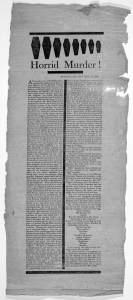 Jen Blood on the Maine Crime scene today… I’ve been racking my brain for about a week now, looking for something extraordinary and entertaining for this month’s post with Maine Crime Writers. After Chris’s eloquent article on Monday, I thought I’d take a much less timely or studied approach while nonetheless continuing on the theme of Maine Crime… The crime this time, however, took place over two hundred years ago. I first began researching the grisly tale for a short story I wrote and then produced as a radio drama with WRFR, our local public broadcasting station in Rockland:
Jen Blood on the Maine Crime scene today… I’ve been racking my brain for about a week now, looking for something extraordinary and entertaining for this month’s post with Maine Crime Writers. After Chris’s eloquent article on Monday, I thought I’d take a much less timely or studied approach while nonetheless continuing on the theme of Maine Crime… The crime this time, however, took place over two hundred years ago. I first began researching the grisly tale for a short story I wrote and then produced as a radio drama with WRFR, our local public broadcasting station in Rockland:
IT WASN’T THE GHOSTS THAT DREW ME TO THE STONE HOUSE. It wasn’t even the history, really. Not the mystery, nor the murder. Or murders, actually—eight of them over two hundred years before, when a supposedly upright former Harvard professor named Isaiah Burch took an axe to six of his seven children and his wife one night, then used his finest straight razor to slit his own throat.
But it wasn’t the murders that brought me to the house, either. No. Erin Solomon brought me there that day. The history and the mystery and the murder were just a convenient excuse. Solomon brought me there…
The ghosts just made me stay.
You can listen to the full audio here. It is based, albeit loosely, on the Purrington mass murder of 1806.
I first heard about the Purrington (there is much confusion as to the correct spelling of the name; I’m going with this one, but it’s also referred to as Purington and Purrinton) murders while doing a story on the Maine Greyhound Placement Service for Downeast Dog News a few years ago, because MGPS is actually built either on or near the site where the Purrington house once stood. While interviewing one of the volunteers there, he brought up the story. I promptly went home and researched, and stored it away as something I wanted to draw on at some undefined point in the future.
In 1805, Captain James Purrington moved with his family from Bowdoinham, Maine, to a farm on Old Belgrade Road in Augusta. From everything I’ve read thus far, he was a moody, dark sort of fellow, and my guess based on the highs and lows and what was called “hereditary madness” when people spoke about him after the fact, is that he probably suffered from bipolar or schizophrenia or some other illness that, in another time, might have been treated before things got out of hand. Unfortunately, that’s not the way things happened for the Purrington family.
Here’s an account from a hand-printed bill that detailed the night of the crime, on July 9, 1806:
“Between the hours of 2 and 3, a near neighbor, Mr. Dean Wyman, was awakened by the lad who escaped, with an incoherent account of the horrid scene from which he had just fled; he, with a Mr. Ballard, another neighbor, instantly repaired to the fatal spot, and here, after having lighted a candle, a scene was presented which beggars all description.–In the outer room lay prostrate on his face, and weltering in his gore, the perpetrator of the dreadful deed–his throat cut in the most shocking manner, and the bloody razor lying on a table by his side–In an adjoining bed-room lay Mrs. Purrinton in her bed, her head almost severed from her body; and near her on the floor, a little daughter about ten years old, who probably hearing the cries of her mother, ran to her relief from the apartment in which she slept, and was murdered by her side…”
What always gets me about these sorts of things is the graphic nature of the text. And, beyond that, you’ll note the depiction of the eight caskets on the bill (pictured above) — two large, the others lined up from largest to smallest. Eeks. According to the story, James Purrington was buried apart from the rest of the family, the axe and straight razor in the coffin with him. Though technically pre-Victorian, the account already shows that lurid fascination with the macabre the Victorian era is renowned for. The mid- to late- 1800s saw the return of so-called “mourning jewelry” – first made popular in the 1600s, jewelry made from a loved ones’ clothing, hair, or even bones – as well as the by-now-familiar memento mori death portraits. The Purrington murders pre-date those portraits by decades, but I took some liberties with my short story and included one such portrait – the image was just too chilling to resist.
The full story was that Purrington took an axe and murdered his wife, six of his eight children, and then killed himself with a straight razor. A seventeen-year-old son – the “lad” mentioned in the article – escaped with only minor injuries, while fifteen-year-old daughter Martha survived for another three weeks before she finally succumbed to her injuries.
The Pulitzer Prize-winning novel A Midwife’s Tale tells the story of Martha Ballard, a midwife with the incredible reputation of having never lost a mother in over one thousand births. Ballard was the midwife for the younger of the Purrington children, and the night of the murder it was Ballard’s home that the surviving son, seventeen-year-old James Purrington, fled to. The midwife detailed the night of the murder in her journal, and part of that story is told in Midwife’s Tale (which was later made into an award-winning PBS documentary).
I’ve altered other details of the crime to make everything fit within the fabric of my short story, including changing James Purrington from a captain with a history of ups and downs to a former Harvard professor who had been the picture of health. There is no greyhound farm in the story, but rather an old ice house and Freeport’s Stone House – a rambling estate I came to love while attending the University of Southern Maine’s Creative Writing MFA, as most of the MFA’s conferences and workshops were held there. But the spirit of the crime, that chilling knowledge that something dark and inexplicable happened in this place, remains.
The final line that captured my imagination and always makes me pause, is toward the end of the hand-printed bill, and was italicized by the original author.
“The ways of Providence are dark and mysterious! yet God is just! and man, weak man, must tremble and adore!”
You can read the full text from the hand-printed bill here.
January 19, 2016
Edgar Allan Cozy
by Barb, in Key West, where it’s a brisk 63 degrees today and the natives are shivering and moaning and wearing parkas
 Yesterday was Edgar Allan Poe’s 207th birthday, and over at Wicked Cozy Authors we marked the day by publishing our “tribute” book of stories and poems inspired by his work.
Yesterday was Edgar Allan Poe’s 207th birthday, and over at Wicked Cozy Authors we marked the day by publishing our “tribute” book of stories and poems inspired by his work.
Most of you probably know that I also blog at Wicked Cozy. We’re a group of authors and long time friends who were originally bound by our subgenre (cozy mysteries) and our settings (New England from Connecticut to Maine). Since those early days, we’ve branched out quite a bit and have published romantic suspense, short stories and (coming soon) historicals, in settings that range from southern Indiana to Ireland.
Last spring, one of our “Wicked Accomplices” and regular bloggers, Jane Haertel (aka Sadie Hartwell at Kensington and Susannah Hardy at Penguin) proposed that with things going so swimmingly at the blog, we should publish a book of short stories.
My first thought was, “It will never work.” In fairness, this is my first reaction to just about anything. I’m sure that sounds odd for someone who was an executive at three successful start-ups, but I learned early on that resources and time are finite and saying “no,” was often as important as saying, “yes.”
Plus, I had just finished having partial responsibility for an anthology at Level Best Books, and it seemed perverse to jump back in so soon.
But as anyone who knows me will tell you, I usually come around. As I did in this case, especially after the idea took hold that the stories would be inspired by a work by Poe.
Stephen King says that story ideas often come down to seeing two things and having them come together in some new and interesting way. When I thought of Poe, two things that had been rattling in my brain came together.
One was this: What if you moved “The Raven” to modern times and the narrator was harangued not by a bird, but by a telemarketer?
Once upon a weeknight dreary, while I watched, alone and bleary
Leonard on the Big Bang Theory, courting Penny from next door
Suddenly I felt a tingle, then my nether regions jingled
A cell phone call? I’d let it ringle, echoing across the floor.
The other was inspired by a scene in the movie City Slickers when Billy Crystal’s character, who sells advertising time for a radio station, complains that he “sells air.” I liked the idea of someone selling “time,” i.e. selling my hapless narrator a timeshare.
Now I knew she was a scammer, and a flimmer and a flammer
She cut me to the quick, God damn her, when she mentioned my Lenore
“There’s one thing,” I said, “I’m sure of. Time’s the thing you can’t buy more of.
Even rich men have no cure of death when he comes through the door.”
Thus, my version of “The Raven,” was born.
You’d think the hard part would be the keeping the rhythm and finding all the rhymes, but instead, the hard part was finding a story arc, and a middle and an end, just like writing a novel or a short story. The muddling middle gets you every time.
You can read all the stories with the simple expenditure of $2.99 on Amazon.
When cozy mystery writers meet Edgar Allan Poe, the result is Edgar Allan Cozy. Each story in this suspenseful new anthology is inspired by the work of Poe. “The Raven,” “The Lighthouse,” “MS. Found in a Bottle,” “The Tell-Tale Heart,” “The Cask of Amontillado,” and “Annabel Lee” have been updated and set in the fictional town of Raven Harbor, Maine. With stories by Sheila Connolly, Edith Maxwell, Sherry Harris, Barbara Ross and Sadie Hartwell. Edited by Sadie Hartwell.
Readers: What do you think of this project? Whose work should inspire out next collection?
January 18, 2016
In My Study There’s …
Lea Wait, here! Over the years lots of people have asked me what was in my study. (A crystal ball? A rabbit’s foot?)
Actually, in addition to books and papers I’m actually using on a day-to-day basis, I do have a lot of memories tucked into various corners of my study. There’s the picture of my husband and I dancing in a Paris Street. An antique print of a Great Blue Heron. A button that reads, “STET, DAMMIT!” on my bulletin board. And a lot more. So, today, come with me on a tour … welcome to where I spend most of my days – and some of my nights~!

19th C medical book, books on poisons, costumes

Ceramic Pencil Holder made by my daughter Liz

Noted for future books

Books on Needlepoint

My daughters, Xmas, 1987
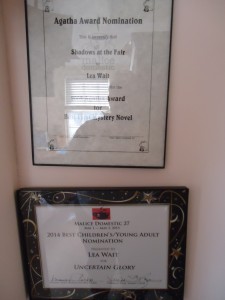
Agatha Award Nomination
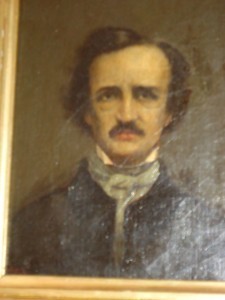
My hero!

Reference Books & Etcs …
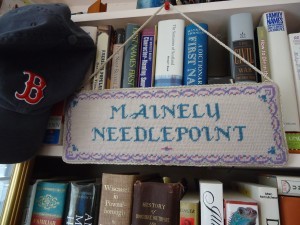
Gift from Reader
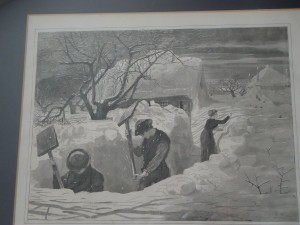
Winslow Homer wood engraving – “Digging Out”

My writing assistant, making a few edits

Smocked pillow made by my sister Nancy’ Seaward Born pillow quilted by young fan

Teddy Bear I gave the guy I loved when he had heart surgery in 1982. He returned it to me when we moved in together in 2003.

19th C wardrobe re-purposed for office supplies (Blankets for cat on top!)

19th C brass stencils
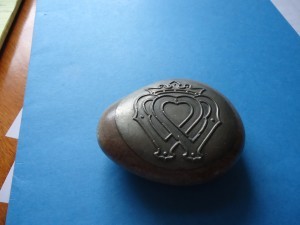
Mary Queen of Scots paperweight from Edinburgh
January 17, 2016
In Which I Actually Talk About Maine Crime
By Chris Holm
For a blog called Maine Crime Writers, we talk very little about Maine crime. That’s understandable, I suppose. For one thing, there’s damn little of it, per capita. For another, most of us are here because we love the state, and are therefore disinclined to shine a light on its shortcomings. But last week, it seemed Maine crime was all anybody was talking about.
At a recent town hall meeting, Governor LePage described Maine’s heroin problem thusly:
“These are guys with the name D-Money, Smoothie, Shifty… these types of guys… they come from Connecticut and New York, they come up here, they sell their heroin, they go back home. Incidentally, half the time they impregnate a young white girl before they leave, which is a real sad thing because then we have another issue we have to deal with down the road.”
LePage’s comments were—by any measure—racist and insulting, and the media’s response was swift. Rachel Maddow and The Daily Show had their fun. Presidential candidates on both sides of the aisle weighed in. A local musician remixed his remarks. A novelty Twitter account parodied them. A second-rate lad-mag hack penned the hastiest of hot takes wondering if the nation would be better off selling our great state to Denmark for a tidy profit.
I’m not here to add fuel to the flames or spark a political discussion in the comment section. In fact, although I found his statements wrongheaded and offensive, I think the governor’s frustration over Maine’s drug problem is sincere, if misplaced. His comments touched on a common misconception among Mainers: namely, that crime (and, in specific, drug crime) is something imported by people From Away.
The fact is, our heroin problem has its roots in prescription opiate abuse, and the recent crackdown on same. This summer, the Washington Post ran a devastating long read about Maine’s heroin epidemic, centering on one well-to-do Falmouth family whose two sons overdosed within twenty-four hours of each other:
They were kids who had it made, at least on paper… They had cars, money and plenty of independence, like many teens in Falmouth, a town of 11,000, a place of privilege just across a short bridge from Portland, the state’s largest city.
It’s a place now ravaged by heroin—four overdoses, two of them fatal, in the past 10 months, in a town more accustomed to nothing of the kind. Maine is at the burning core of a nationwide heroin epidemic, the perverse outcome of a well-intentioned drive to save Americans from the last drug craze, a widespread hunger for heroin’s chemical cousin, prescription opiate pills such as Oxycontin.
Heroin—now cheap, plentiful and more potent than ever—is killing people at record rates. Across the nation, deaths from heroin overdoses nearly quadrupled in the decade ending in 2013, according to a new analysis by the Centers for Disease Control and Prevention.
In Maine, deaths from heroin overdoses ballooned from seven in 2010 to 57 last year. Two-thirds of the victims were, like David, adults in their 20s and 30s. In 2012, heroin accounted for 8 percent of the caseload for Maine’s Drug Crimes Task Force; last year, it jumped to 32 percent. In Portland, the number of addicts served by the needle exchange nearly doubled in just two years. Today in Maine, a single tablet of Oxycontin often costs $50; addicts can find a single-dose packet of heroin for as little as $10.
I urge you all to read the whole piece if you have a chance. It might just change your perspective on the matter.
To give the governor some small measure of credit, I understand the temptation to see Maine’s drug problem as the result of some easily demonized Other that can be defeated (although I find it troubling that his idea of Other is ‘brown people from New York and Connecticut’), but we’ll never solve it thinking like that.
The problem is us—and the solution is us, too.
We need to expand programs like this one that get addicts into recovery, rather than locking them up or tossing them back onto the street. We need to pressure state lawmakers to approve funds for new rehab facilities. We need to treat drug users with compassion, not hostility.
Oh, and if any of you decide you need a new target for your hostility, I recommend the aforementioned lad-mag hack. Maybe, as this hilarious response to his piece suggests, we can sell him to Denmark for a tidy profit.

